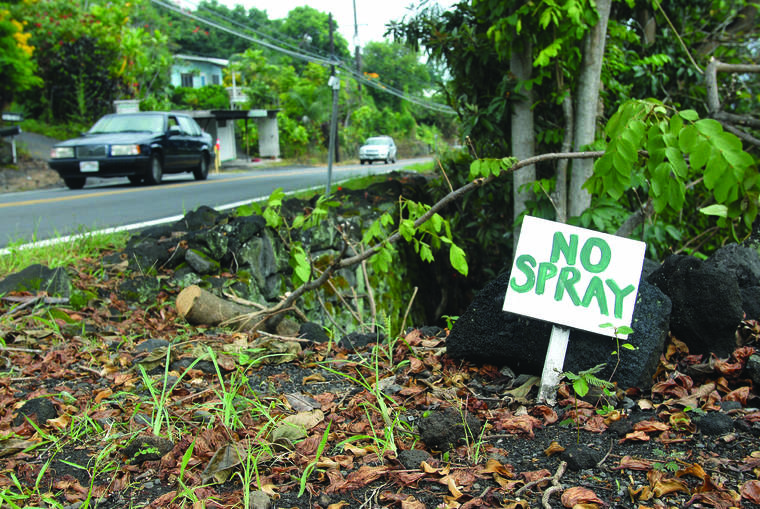Herbicide ban advances

HILO A ban on the countys use of weedkillers in parks and along its highways advanced Wednesday on an 8-1 vote, although some members of the County Council asked for more clarification before its final vote later this month.
HILO — A ban on the county’s use of weedkillers in parks and along its highways advanced Wednesday on an 8-1 vote, although some members of the County Council asked for more clarification before its final vote later this month.
Bill 101, sponsored by Kona Councilwoman Rebecca Villegas, would, over a four-year period, ban the use of herbicides in parks and alongside roads, bike-ways, sidewalks, trails, drainage-ways and waterways owned or maintained by the county. The bill includes a lengthy list of specific chemicals to be banned.
“We do have the capability as well as the responsibility as a county,” said Villegas. “I feel like the community has spoken and asked us to change the way we care for public spaces.”
Kohala Councilman Tim Richards was the sole no vote. He worried about the financial impact of increased manpower and the carbon impact of increased mowing machinery, as well as the precedent set that he feared could lead to a ban that also affects the private sector.
“If we remove all the ability to use any of these things going forward, we’re going to be shortsighted,” Richards said. “I believe that this is a conversation about safety and about responsible use of the products.”
Hilo Council members Sue Lee Loy and Aaron Chung, the council chairman, said they’d like to see more tweaks before the final vote. Both were concerned abut how Hilo Municipal Golf Course could be managed without herbicides.
“We’ve got to figure out where the knots are and get them untangled,” Lee Loy said.
Cost was also a cause for concern, with Parks and Recreation Director Roxcie Waltjen estimating she’d need 400 additional park maintenance workers at about $39,000 salaries to pull weeds and keep the 183 parks at their current condition.
Public Works Director David Yamamoto said he’d also need more staff and equipment, but he currently has “no idea” how much that will cost. The department would hire a consultant to figure it all out, he said.
Both departments said they’ve already cut their herbicide use by half. In addition, four parks have been selected for pilot projects that involve the cessation of herbicide use: Hilo soccer field No. 4, Old A Park football field, Waikoloa Park and Pahoa District Park.
Autumn Ness, program director of the group Beyond Pesticides, who helped draft the measure, said the transition can be accomplished at the same budget the departments currently get.
“This is a really difficult thing to do, but we’ve got to start somewhere,” said South Kona/Ka‘u Councilwoman Maile David. “This is a step in the right direction — its not the answer to everything.”
The bill calls for a transition period starting Jan. 1, with an outright ban being implemented by Jan. 1, 2024. A seven-member “vegetation management transition committee,” appointed by the mayor and confirmed by the council, will monitor the county’s progress during the transition period.
Rules would be put in place during the transition period for the county departments of Environmental Management, Parks and Recreation and Public Works requiring posted notices, blocking off of areas treated during a drying period, the use of a blue dye to identify treated areas and adherence to label directions, such as restrictions during wind and rain conditions.
In the meantime, people can volunteer to maintain their own roadsides and put up signs asking it not be sprayed by filling out a form on the Public Works website https://records.co.hawaii.hi.us/weblink/1/doc/66492/Electronic.aspx.
The bill doesn’t apply to private property or to citizens who maintain land adjacent to county easements or lease agricultural land from the county.
Among testifiers, supporters outnumbered opponents about 2-to-1, with most supporters asking that the effective date be moved earlier than 2024. Some testifiers shared personal stories of health problems they attributed to herbicide spraying. Others talked about the danger of toxins washing into the oceans.
“Many of these herbicides will find their way to coral reefs. Almost all of them will cause corals to bleach under non-bleaching conditions,” said Craig Downs, executive director of the Lynchburg, Virginia-based Haereticus Environmental Laboratory. “Many of these herbicides will affect phytoplankton and limu (and have an) impact to humans.”
Abel Lui showed photos of birds he said were killed by crews spraying herbicides along Highway 11 in Ka‘u.
“I got pictures of them. Look at them … They all died. … All I ask, stop what you guys doing,” Lui said. “The county go all the way to Naalehu and they’re spraying on the side while people walking around. … The parks, they’re spraying in the parks and they’re not supposed to be spraying in the parks.”
His caregiver Katrina Morgan said she’d sent a carcass of a pueo to the state Environmental Health Administration for analysis. She said there were levels of herbicide chemicals in the bird, although not enough glyphosate to kill it.
Opponents, many from agricultural, nursery and tropical floral industries, worried the ban for government operations would lead to a countywide and then a statewide herbicide ban that would endanger their livelihoods.
“This is just the first step in their efforts to ban all herbicides in the state of Hawaii,” said Gordon Inouye of the Hawaii Floriculture and Nursery Association. “All I ask is, we seek balance in the decision we make.”


